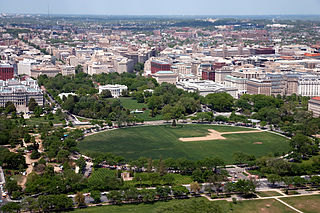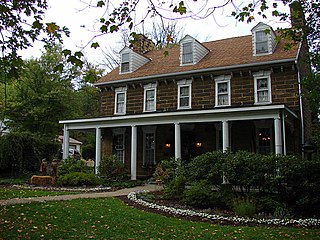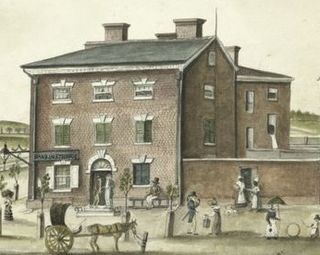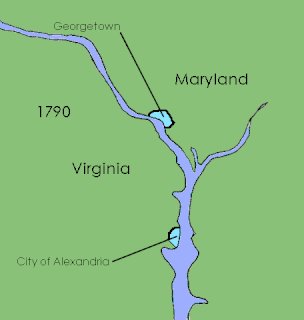Related Research Articles

Georgetown is a historic neighborhood and a commercial and entertainment district located in northwest Washington, D.C., situated along the Potomac River. Founded in 1751 in the Province of Maryland, the port of Georgetown predated the establishment of the federal district and the City of Washington by 40 years. Georgetown remained a separate municipality until 1871 when the United States Congress created a new consolidated government for the whole District of Columbia. A separate act passed in 1895 specifically repealed Georgetown's remaining local ordinances and renamed Georgetown's streets to conform with those in the City of Washington.
Pierre Charles L'Enfant, self-identified as Peter Charles L'Enfant while living in the United States, was a French-American military engineer who designed the basic plan for Washington, D.C. known today as the L'Enfant Plan (1791).

Theodore Roosevelt Island is an 88.5-acre (358,000 m2) island and national memorial located in the Potomac River in Washington, D.C. The island was given to the federal government by the Theodore Roosevelt Association in memory of the 26th president, Theodore Roosevelt. Until then, the island had been known as My Lord's Island, Barbadoes Island, Mason's Island, Analostan Island, and Anacostine Island.

The history of Washington, D.C., is tied to its role as the capital of the United States. Originally inhabited by an Algonquian-speaking people known as the Nacotchtank, the site of the District of Columbia along the Potomac River was first selected by President George Washington. The city came under attack during the War of 1812 in an episode known as the Burning of Washington. Upon the government's return to the capital, it had to manage reconstruction of numerous public buildings, including the White House and the United States Capitol. The McMillan Plan of 1901 helped restore and beautify the downtown core area, including establishing the National Mall, along with numerous monuments and museums.

The Ellipse is a 52-acre (21 ha) park south of the White House fence and north of Constitution Avenue and the National Mall. Properly, the Ellipse is the name of the five-furlong (1.0 km) circumference street within the park. The entire park, which features various monuments, is open to the public and is part of President's Park. The Ellipse is also the location for a number of annual events. D.C. locals can often be heard to say they are "on the Ellipse," which is understood to mean that the individual is on the field that is bounded by Ellipse Road.

The City Tavern Club is a private club in the Georgetown area of Washington, D.C., United States. It is housed in the City Tavern, one of the oldest buildings and the last remaining Federal-period tavern in the city.

Streetcars and interurbans operated in the Maryland suburbs of Washington, D.C., between 1890 and 1962. Lines in Maryland were established as separate legal entities, but eventually they were all owned or leased by DC Transit. Unlike the Virginia lines, the Washington and Maryland lines were scheduled as a single system. Most of the streetcars were built with grand plans in mind, but none succeeded financially. A combination of the rise of the automobile, various economic downturns and bustitution eventually spelled the end of streetcars in southern Maryland.

Spurrier's Tavern was a well-known tavern and horse-changing depot which stood by the main road between Baltimore and Washington, D.C. from 1771 to 1835 near what is now Jessup, Maryland. George Washington visited the tavern several times during his presidency. After an 1835 fire, the building was repaired for residence by the family of its owner, who died there in 1852. It was demolished sometime thereafter.

The Old Stone House is the oldest unchanged building in Washington, D.C., United States. The house is also Washington's last Pre-Revolutionary colonial building on its original foundation. Built in 1765, Old Stone House is located at 3051 M Street, Northwest in the Georgetown neighborhood. Sentimental local folklore preserved the Old Stone House from being demolished, unlike many colonial homes in the area that were replaced by redevelopment.

Arlington Ridge is an neighborhood in Arlington County, Virginia, United States. It is bordered on the north by The Pentagon, on the west by the Army Navy Country Club, and on the south the City of Alexandria. The main thoroughfare is the eponymous Arlington Ridge Road, a mansion-lined boulevard that, due to its high elevation, offers picturesque views of Washington D.C. and the surrounding areas. Also known simply as "The Ridge", this community is home to two historical points of interest: the Hume School, currently the site of the Arlington Country Historical Society and Museum, and Fort Scott, currently the site of Fort Scott Park.

John Mason was an early American merchant, banker, officer, and planter. As a son of George Mason, a Founding Father of the United States, Mason was a scion of the prominent Mason political family.

Hill's Tavern is a historic building in Scenery Hill, Pennsylvania. It was heavily damaged by a fire that started shortly before midnight on August 17, 2015. For a period in the early 1900s, the inn was known as Central Hotel. Now called the Century Inn, it has been claimed to have been the oldest tavern in continuous use on the National Road, until the fire brought an end to its 221 years of continuous operation.

The Old Stone Tavern is a historic building located at 434 Greentree Road, block and number 19-S-156, in the West End Village neighborhood of Pittsburgh, Pennsylvania. The Tavern dates back to at least 1782, and more likely 1777.

Rhodes Tavern is the site of a historic tavern in the early history of Washington, D.C. It was located at 15th Street and F Street, Northwest, Washington, D.C.

The L'Enfant Plan for the city of Washington is the urban plan developed in 1791 by Major Pierre (Peter) Charles L'Enfant for George Washington, the first President of the United States.
John Gadsby was an English tavernkeeper in Alexandria, Baltimore, and Washington, DC.
Juan de Miralles was a Spanish arms dealer who became friends with George Washington during the American Revolutionary War. He supported the American cause financially, and served as a link between the colonists and the Spanish Crown.
Pedro Pablo Casanave , also known as Peter Casanave, was a prominent Spanish merchant and politician who served as the fifth mayor of Georgetown and Master Masonic. He was also a member of the Georgetown Corporation's Common Council. Casanave is particularly remembered by directing the construction and having laid the Cornerstone in what later became in the White House on October 12, 1792. Although, information about him remains scarce.
The following is a timeline of the history of the city of Washington, D.C., USA.

The District of Columbia was created in 1801 as the federal district of the United States, with territory previously held by the states of Maryland and Virginia ceded to the federal government of the United States for the purpose of creating its federal district, which would encompass the new national capital of the United States, the City of Washington. The District came into existence, with its own judges and marshals, through the District of Columbia Organic Act of 1801; previously it was the Territory of Columbia. According to specific language in the U.S. Constitution, it was one hundred square miles (259 km2).
References
- ↑ Holmes, Oliver W. (1980). The City Tavern: A Century of Georgetown History, 1796-1898. Columbia Historical Society; City Tavern Association reprint. p. 5.
- ↑ "The Old Stone House". National Park Service. Retrieved 2009-02-24.
- ↑ Ecker, Grace Dunlop (1933). A Portrait of Old Georgetown. Garrett & Massie, Inc. p. 18.
- ↑ Holmes, Oliver W. (1980). The City Tavern: A Century of Georgetown History, 1796-1898. Columbia Historical Society; City Tavern Association reprint. pp. 2, 5.
- ↑ Holmes, Oliver W. "Suter's Tavern: Birthplace of the Federal City". Records of the Columbia Historical Society. 73-74: 1–34.